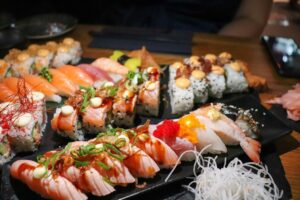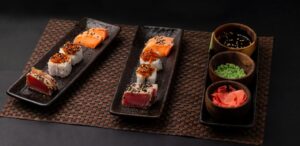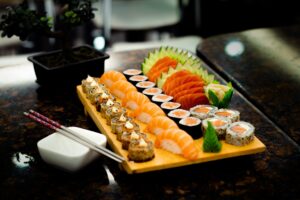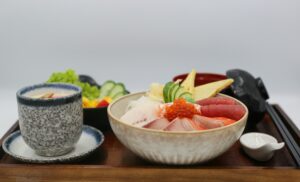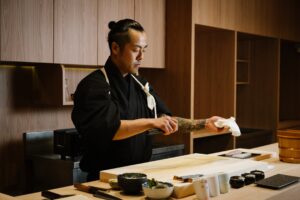
Achieving Japanese Cuisine Restaurant Excellence: Our Standard for Authentic Dining
In the world of authentic Japanese dining, we believe that every element tells a story of dedication and respect. As a team who have devoted our careers to mastering the intricate art of this culinary tradition, we understand that true Japanese cuisine embodies far more than simply serving food—it represents centuries of cultural heritage, seasonal harmony, and an unwavering commitment to perfection.
The crucial distinction between exceptional Japanese restaurants and mere imitations lies not just in technical execution, but in the profound respect for age-old traditions that guides every step of the dining experience. This respect begins with the meditative precision required for proper sushi rice preparation (shari), extends to the meticulous knife work required for sashimi, and dictates our approach to sourcing premium ingredients.
Authentic Japanese dining is fundamentally a philosophical approach to food that honors both nature’s gifts and human craftsmanship. When you choose an establishment committed to these principles, you are invited to savour a culinary experience where tradition enhances the taste of every dish, allowing you to truly appreciate the harmony of flavors and the freshness that define our craft. Our dedication ensures that every meal is an unforgettable meal that delights your taste buds and reflects the best Japanese food culture.
What Defines an Exceptional Japanese Cuisine Restaurant
As practitioners of authentic omakase dining in Singapore, Sushi Masa by Ki-Setsu understands that an exceptional Japanese cuisine restaurant distinguishes itself through unwavering adherence to core principles that have been refined for generations.

The Importance of Shun (Seasonality)
At the foundation of our philosophy lies a deep respect for seasonal ingredients. We believe menus must evolve naturally with nature’s rhythms to showcase the freshest produce and seafood at their peak flavor. This seasonal approach, known as shun (旬), is non-negotiable. It ensures that every dish we prepare offers a unique and perfect reflection of the current moment in time. Exceptional cuisine is dictated by nature’s quality, not by a fixed year-round menu, a hallmark of the best Japanese restaurants.
The Spirit of Omotenashi (Hospitality)
The concept of omotenashi (おもてなし)—selfless hospitality that anticipates a guest’s needs without intrusion—permeates every interaction within truly authentic Japanese restaurants. This philosophy extends far beyond mere service; it is about creating an atmosphere where diners feel genuinely and attentively cared for, allowing them to fully immerse themselves in the quiet culinary journey ahead, enhancing the overall Japanese dining experience.
Mastery Through Traditional Training
Genuine Japanese cuisine is built upon traditional techniques. Chefs dedicate years to perfecting fundamental skills before they are ever entrusted with complex preparations. The mastery of intricate knife work, precise rice seasoning, and delicate fish handling requires a patient apprenticeship under experienced masters. This methodical approach ensures that every chef understands not just how to perform a technique, but the profound why behind it, creating a deep foundation of culinary excellence that is reflected in every single bite and signature dish served at the restaurant.

Essential Types of Japanese Restaurants
The landscape of Japanese dining encompasses diverse formats, each meticulously preserving specific aspects of our culinary heritage. Understanding these distinctions helps appreciate the unique character and cultural significance of each dining experience within the realm of authentic Japanese cuisine restaurants.
Sushi-ya: The Heart of Edomae Mastery
Traditional sushi restaurants represent perhaps the most recognizable form of Japanese cuisine, yet their apparent simplicity masks an extraordinary technical complexity.
- The Edomae Foundation: The Edomae technique, which originated in Tokyo, established the fundamental standards for sushi preparation that guide the finest sushi-ya today. The entire experience revolves around precise preparation, not just serving raw fish, highlighting the importance of premium ingredients.
- The Rice Imperative: The foundation of exceptional sushi lies in perfect rice preparation (shari). Each grain must be seasoned with a precisely balanced blend of vinegar, sugar, and salt, then maintained at body temperature to complement the fish. Our own training begins with years dedicated solely to mastering the rice before we are permitted to handle a knife, underscoring our belief that inferior rice renders even the finest seafood meaningless.
- The Intimate Theater: Many authentic sushi bars feature an open kitchen layout and private rooms to enhance the dining experience. This allows guests to witness the chef’s skill, timing, and attention to detail firsthand. The relationship between the chef and diner at the counter creates an intimate theater where technique and seasonal selection combine to create unforgettable dining experiences.
- The Ultimate Trust (Omakase): Omakase dining at these establishments represents the ultimate expression of trust between chef and guest. Rather than ordering from a menu, diners surrender control to the chef’s expertise, allowing for a personalized progression through carefully selected preparations that showcase both seasonal ingredients and technical mastery, including unique menu items like foie gras chawanmushi.
Kaiseki and Fine Dining Establishments
Kaiseki represents the pinnacle of formal Japanese dining, with roots tracing back to the traditional tea ceremony.
- Harmony and Aesthetics: These elaborate multi-course experiences showcase seasonal ingredients through carefully orchestrated presentations that engage all five senses while telling stories about nature’s changing rhythms. The philosophy emphasizes harmony between the food, the serving vessels, and the season.
- Structured Progression: Traditional kaiseki follows specific structural guidelines, progressing from light appetizers through various cooking methods before culminating in a rice course, soup, and pickled vegetables.
- Contemporary Adaptations: Contemporary fine dining specializing in Japanese cuisine frequently incorporates these kaiseki principles into more accessible formats. They serve as cultural bridges, educating guests about Japanese food philosophy while creating memorable meals that honor the spirit of aesthetic refinement. These restaurants often feature cocktails crafted to complement the delicate flavors of each course, enhancing the overall dining experience.
Izakaya and Casual Japanese Dining
Izakaya serve as the social heart of Japanese dining culture, offering casual environments for sharing small plates and enjoying Japanese beverages.
- Shared and Social: These establishments offer an accessible way to experience diverse flavors and textures, with popular dishes like yakitori (chicken skewers), tempura, and various grilled preparations showcasing fundamental Japanese cooking techniques in approachable formats.
- Everyday Tradition: Izakaya play a crucial role in preserving everyday Japanese food traditions, maintaining authenticity through careful sourcing and proper technique.
- Beverage Culture: The role of sake and other Japanese beverages is essential. Proper beverage pairings, including thoughtfully designed cocktails, enhance food flavors and create the convivial, relaxed atmospheres that encourage conversation and sharing, especially during sun-lit evenings or lively nights.
The Foundation of Best Japanese Restaurants
The authenticity of any Japanese cuisine establishment rests upon fundamental principles that guide ingredient selection, preparation methods, and service philosophy. We believe these core elements distinguish genuine operations from imitations, ensuring that traditional standards continue to evolve meaningfully.

Premium Ingredients and Sourcing
Exceptional quality starts with superior ingredients and fresh ingredients. We prioritize the use of fresh, premium ingredients above all other considerations, understanding they form the non-negotiable foundation for outstanding dishes in a true Japanese cuisine restaurant.
- Direct Relationships: We maintain direct relationships with suppliers, often sourcing specific items, including fresh fish and specialty produce, from Toyosu Market in Tokyo and other premier Japanese suppliers. This dedicated commitment to sourcing ensures we can access ingredients that showcase the true diversity of Japan’s waters and land, which is why the best Japanese restaurants in Singapore offers only the freshest produce.
- Cost Justification: The investment required to uphold these standards is reflected in the final experience. Fresh fish flown in from Japan, seasonal vegetables at peak ripeness, and artisanal products created by master craftsmen all carry premium costs. This dedication ensures that every dish served meets the exacting standards our guests expect while supporting traditional producers.
Traditional Techniques and Craftsmanship
Japanese cooking encompasses numerous fundamental techniques that require years to master properly. This commitment to craft is essential in any reputable Japanese cuisine restaurant.
- Core Skills: Techniques like precise raw preparation demand absolute precision in knife work and timing. Similarly, mastering the preparation of various proteins (including fish, chicken, beef, and pork) for dishes like yakitori, yakiniku, or sushi is an essential part of our training, requiring comprehensive skill development.
- The Power of the Knife: Knife skills represent the most crucial technical foundation. The ability to break down whole fish, create uniform vegetable cuts, and slice sashimi with consistent thickness requires thousands of hours of practice. Our training philosophy emphasizes that speed without precision is worthless; the meditation-like focus required for proper knife work develops the mental discipline necessary for all aspects of Japanese cooking.
- Rice Preparation: Rice preparation techniques are paramount and vary by dish. For sushi rice, this involves careful washing, cooking to specific moisture levels, seasoning while warm with a precisely balanced vinegar mixture, and cooling it to body temperature while maintaining the integrity of each individual grain. This attention to detail ensures a comforting bowl of rice that perfectly complements the fresh fish and other components of the meal, a signature dish in the best Japanese restaurants.

The Japanese Dining Experience: Beyond the Food
Aside from the concept of omotenashi and seasonal menus, the dining environment is also an essential extension of our culinary philosophy. We ensure that factors like traditional décor, subtle Japanese interior elements, and attentive service all play a crucial role in creating an ambiance that enhances authenticity in a Japanese cuisine restaurant. These restaurant features ensure that the dining experience is not just about taste, but about cultivating a peaceful, dedicated space where the focus is entirely on the food and the craft.
Choosing the Right Japanese Cuisine Restaurant for Your Occasion
Selecting an appropriate Japanese cuisine restaurant requires considering multiple factors, including the occasion, desired experience level, and budget constraints, as different establishment types serve distinct purposes.
For intimate celebrations or business entertaining, omakase experiences at dedicated sushi bars provide personalized attention and educational opportunities, though they typically require advance reservations and have specific opening hours.
For casual occasions, the izakaya experience encourages sharing and exploration of diverse flavors in relaxed environments, often featuring comforting, hearty meals like a bowl of donburi or ramen with springy noodles.
When evaluating authenticity, consider factors such as chef backgrounds, ingredient sourcing practices including connections to Toyosu Market, and seasonal menu variety. The most genuine establishments typically employ chefs with formal training and maintain a commitment to traditional preparations alongside any meaningful modern adaptations that incorporate global flavours.
The Future of Japanese Restaurants in Singapore
The evolution of Japanese restaurants continues as traditional practices adapt to global dining preferences while preserving essential cultural elements. We see contemporary trends focusing on plant-forward dishes, integrating subtle global flavors, and maintaining transparency in sourcing premium ingredients. New innovations also aim to excite the palate with unique dessert experiences that offer modern twists on traditional treats, such as incorporating onsen egg in creative dishes.
Successful Japanese cuisine will continue emphasizing authentic techniques and quality ingredients while adapting presentation and service styles to suit diverse diners. The fundamental principles of seasonality, craftsmanship, and omotenashi remain timeless, providing a stable foundation for growth. The enduring appeal lies in its ability to provide both sensory pleasure and cultural education, fostering a deeper appreciation for sophisticated culinary traditions.

Whether you are searching for a hidden gem in Cuppage Plaza or Chinatown Point, or a refined dining experience at Marina Bay Sands, Singapore offers a vibrant scene of Japanese restaurants to satisfy your taste buds and elevate your dining experience.
We remain committed to these traditional principles while continuously refining our techniques and expanding our understanding of Japanese cuisine’s infinite possibilities. We invite you to explore our interpretation of authentic Japanese dining at our Japanese cuisine restaurant, where premium ingredients and age-old traditions come together to delight your taste buds. For an unforgettable meal, you can secure an omakase reservation by emailing us at reservations@kisetsu.com.sg.

